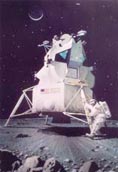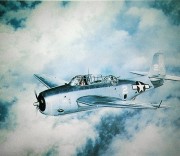|
From Sea to Shining Sea*
By Carlton W. Austin
Seaplane pilots do it on water: feet-wet flying in the Mid-Atlantic.
When Mel Gibson, as the hero of the movie Braveheart, rode before his assembled troops and shouted “Freedom!” he wasn’t talking about flying seaplanes—but he could have been. Because that’s what seaplane flying is all about: Freedom.
Just ask Marshall Gildermaster, a Southwest Airline pilot and floatplane aficionado. “I started down in Louisiana,” he says. “It took only one flight. We were jumping lily pads in a simulation of avoiding floating objects like logs—or alligators. I was hooked.”
That was ten years ago. Now owner of a Cessna 185 on Wipaire amphibious floats, based at his new Lake Anna, Virginia, home, Gildermaster, who also sells seaplane trailers, is preparing for warmer weather when he plans to cut his 2.5-hour commute to BWI down to 45 minutes by flying into Tipton Airport in Ft. Meade, Maryland, just 8 miles from work. When it comes to water flying, “the key thing is the flexibility.”
Not all seaplanes are created equal, though. The term includes flying boats—those with hulls; think Lake amphibian or Grumman Goose—and float planes, which may or may not be amphibious. Because of lower relative cost, most people opt to fly floats, either straight, meaning water only, or amphibious like Gildermaster’s, with Cessna 172s and 185s and Super Cubs being the most numerous types, though Taylorcraft and Maule variants are gaining in popularity. All have one thing in common: They are heaps of fun.
Whether fishing on a pristine lake or hunting in exotic locations or picnicking on a private beach is to your taste, a seaplane can get you there. But your expanded operational environment requires some revised thinking when it comes to takeoffs and landings—and some extra vigilance. Meaning, watch out for sea gulls, ducks and geese.
“There’s a large concentration of sea gulls at Lake Anna,” according to Gildermaster. So far, he’s managed to avoid them, but he did bag a hapless goose while taking off on a flight near Toronto. “It hit mid-prop, which is probably why there was no damage to the plane. But everything was covered with goose blood.”
The Canada trip was unusual, and Gildermaster is more likely to be found exploring waters closer to home: Smith Mountain Lake, the Rappahannock, the Potomac and other Chesapeake Bay tributaries, though not the Bay itself as much. Why? Because float planes prefer calmer waters. “I used to visit Bay Bridge Airport because they had a ramp,” he says. “But when the wind is out of the west, it’s tough.”
So how do you get in on all the fun?
According to Stan Sweikar, instructor and owner-operator of Chesapeake Seaplanes and Wingfield Seaplane Base(MD01) on Jerome’s Creek in St. Mary’s County, Maryland, getting a seaplane rating added to your pilot certificate is a lot easier—and less expensive—than you might think. Working in his 1946 Taylorcraft BCS12D-4-85 (HP) on Edo 1320 floats, Sweikar can get an average pilot ready for his or her checkride in about 5 hours’ flying time. Two to three hours of ground school are also required, but most candidates complete the program over a long weekend. And at a package price of only $925, including checkride, it’s quite a bargain. In fact, many pilots use the rating as a means of satisfying their Biennial Flight Review.
Sweikar claims that with seaplanes it’s all about takeoffs and landings, or “on the water work,” since in the air they fly similarly to other aircraft, except that you do lose about 10-15% of cruise speed because of the extra drag from floats. “Tailwheel experience helps,” says Sweikar, because of the constant rudder use. Taxiing may be most problematic. Floatplanes are “a lot like a windsock,” he says. “There is no neutral. No reverse. You need to think things out before departing or landing.” You need to be VERY sensitive to the wind.
And once airborne, how do you judge the wind? You’ll need to monitor everything from ripples on the water to flags on shore, from boats at anchor, which weathervane like windsocks, to tacking sailboats. As Sweikar advises, “There’s no one on Unicom giving you the active runway—there is no ‘runway.’ ”
Working with Sweikar at the flight school is Ron Smith, president of the Maryland/Chesapeake Bay Seaplane Pilots Association (MCBSPA). Ron, a marine biologist by trade who fell in love with seaplanes after flying his cousin’s float-equipped Citabria one summer in Alaska, also instructs and does sightseeing flights.
Smith echoes the feelings of Sweikar and Gildermaster when it comes to the freedom and flexibility of water flying. But he does offer one caveat. “Certain sections of some rivers are closed,” he cautioned. “It’s always best to check with the State Aviation Administration.” He recommends getting a copy of the Seaplane Landing Directory, available from seaplane.org, the national organization’s Web site. (See sidebar.)
Beyond that, Smith says you can go almost anywhere there’s water. A good way to get your “feet wet,” so to speak, is to attend a “Splash-in,” the seaplane version of a Fly-in. Most are scheduled for the third Saturday of the month from May through September. Visit MCBSPA’s Web site for information regarding dates and times.
Okay, so you can go anywhere, but where will you get avgas? A good question, particularly for those prospective non-amphibious pilots. The answer is you don’t need it. No, seaplanes don’t run on water…well, they do…but…you know. In reality, most are STC’ed for auto gas, so visiting just about any marina will do the trick.
Ah, yes. Freedom! Most pilots would agree: that’s what flying is all about. Only with seaplane pilots, even more so. As Stan Sweikar said when asked about seaplane flying’s appeal, “Bottom line, it’s the sense of freedom.” Yeah.
* * *
“From Sea to Shining Sea” sidebar:
Following are some useful Web resources concerning seaplane flying.
On a national level, Seaplane Pilots Association, whose Web site can be found at www.seaplane.org, offers not only a bi-monthly magazine but also the aforementioned Seaplane Landing Directory. They also provide an instructor locator that, while not all-inclusive, allows a state-by-state search for seaplane instructors. Lots of good information here.
For Mid-Atlantic pilots and enthusiasts, Ron Smith invites you to check out Maryland/Chesapeake Bay Seaplane Pilots Association at www.marylandspa.org. Look for scheduled Splash-ins. You don’t have to be a pilot to participate. The one at Suicide Bridge Restaurant on the Choptank River in Cambridge, Maryland, sounds particularly intriguing.
Marshall Gildermaster, who doubles as webmaster for www.marylandspa.org, promotes his seaplane trailer business at seaplanetrailers.com.
* (This article first appeared in Auto Pilot magazine, and is reprinted with permission.)
|



